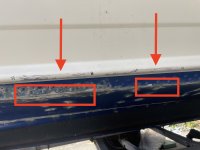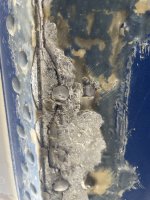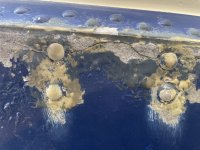jimmwaller
Petty Officer 1st Class
- Joined
- Nov 30, 2013
- Messages
- 265
Hi all, I have been trying to track down a leak in my 22' starcraft islander for a while, and today I think I finally found it. That's the good news, that bad news is that it seems to be coming from a crack in the hull. These boats are aluminum, so I'm looking for advice on options for aluminum hull repair.
I'll do my best to describe it and the photos should help, but essentially, there are two cracks (might just be one long crack?) in the hull. It's almost exactly halfway between the bow and the stern, on the port side. My boat has a moderate V bottom and a line of rivets right where the bottom meets the "walls" of the hull (where it starts to turn vertical)... it's almost a 90-degree angle at that point. The crack(s) are on the "bottom" side (so, not on the vertical walls).
I think there are two cracks, one about 8 inches long and one about 5" long. It's a little hard to tell because the crack goes into the seam (where the walls of the boat meet the bottom) and so I can't tell how far that crack extends. The other crack is about 4 inches away, so they may be the same crack. However, just looking, I think they are two different cracks. I'm guessing there was an impact of some kind.
What are my repair options? I've been using this boat as-is for a few years and have just been dealing with the leak, so it's not too annoying. But now that I found it, I'd like to repair it. I'm guessing this isn't something gluvit can handle (maybe I'm wrong?)? Should I just shove some JB weld in there> My worry is that it might flex too much. Or do I need to have this welded? Or can I try one of those torch weld sticks or something? I'm not sure if this is a structural issue or if it's getting any bigger, but they're still pretty small so I'm guessing they're not growing fast, if at all.
Really looking for options. Happy to explain anything better if I did a bad job, but hopefully the photos help!
Photos:
Here's where they are located:

They're on the "bottom" side, so the side that's facing the ground. This is the port side, so the bow is to the left and the stern is to the right. The longer one is closer to the bow.
Here's a photo of the longer crack (so, I am on the ground, looking up):

There was some paint and some gluvit/epoxy (and something that looked like JB weld, maybe) there, so there are a lot of things that look like cracks, but the actual crack in the metal is the one that winds through the two bare rivets (which, once the paint was off, are clearly damaged). This crack is about 8" long.
And here's a photo of the other crack. This one is maybe 5" long:

Again, lots of paint and epoxy, but the crack is winding between those two top rivets.
I'll spend some time over the next few days sanding off all the paint/epoxy/etc, but I'm anticipating that I have one crack of about 8" and another of about 5". Looking for any and all advice about the best way to deal with this, and how to know whether they are on highly structural components of the hull, etc.
Happy to answer any other questions, if I left stuff out it's because I didn't know that there was other relevant information so will gladly provide any missing info!
Thanks in advance
I'll do my best to describe it and the photos should help, but essentially, there are two cracks (might just be one long crack?) in the hull. It's almost exactly halfway between the bow and the stern, on the port side. My boat has a moderate V bottom and a line of rivets right where the bottom meets the "walls" of the hull (where it starts to turn vertical)... it's almost a 90-degree angle at that point. The crack(s) are on the "bottom" side (so, not on the vertical walls).
I think there are two cracks, one about 8 inches long and one about 5" long. It's a little hard to tell because the crack goes into the seam (where the walls of the boat meet the bottom) and so I can't tell how far that crack extends. The other crack is about 4 inches away, so they may be the same crack. However, just looking, I think they are two different cracks. I'm guessing there was an impact of some kind.
What are my repair options? I've been using this boat as-is for a few years and have just been dealing with the leak, so it's not too annoying. But now that I found it, I'd like to repair it. I'm guessing this isn't something gluvit can handle (maybe I'm wrong?)? Should I just shove some JB weld in there> My worry is that it might flex too much. Or do I need to have this welded? Or can I try one of those torch weld sticks or something? I'm not sure if this is a structural issue or if it's getting any bigger, but they're still pretty small so I'm guessing they're not growing fast, if at all.
Really looking for options. Happy to explain anything better if I did a bad job, but hopefully the photos help!
Photos:
Here's where they are located:

They're on the "bottom" side, so the side that's facing the ground. This is the port side, so the bow is to the left and the stern is to the right. The longer one is closer to the bow.
Here's a photo of the longer crack (so, I am on the ground, looking up):

There was some paint and some gluvit/epoxy (and something that looked like JB weld, maybe) there, so there are a lot of things that look like cracks, but the actual crack in the metal is the one that winds through the two bare rivets (which, once the paint was off, are clearly damaged). This crack is about 8" long.
And here's a photo of the other crack. This one is maybe 5" long:

Again, lots of paint and epoxy, but the crack is winding between those two top rivets.
I'll spend some time over the next few days sanding off all the paint/epoxy/etc, but I'm anticipating that I have one crack of about 8" and another of about 5". Looking for any and all advice about the best way to deal with this, and how to know whether they are on highly structural components of the hull, etc.
Happy to answer any other questions, if I left stuff out it's because I didn't know that there was other relevant information so will gladly provide any missing info!
Thanks in advance



















